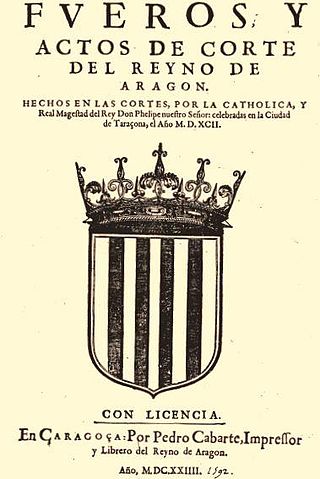Loading AI tools
Court of the Kingdom of Aragon summoned by Philip II of Spain in 1592 From Wikipedia, the free encyclopedia
The Cortes of Tarazona of 1592 were Cortes of the Kingdom of Aragon summoned by Felipe II, being the first Aragonese courts celebrated after the entrance in the kingdom of the royal army to suffocate the alterations of Aragon. The Cortes began on June 15, 1592, and closed on December 2, 1592.

These courts were held after the confrontations in Zaragoza between the supporters of Antonio Pérez on one side, and the Aragonese institutions and the Holy Office on the other, which led to the assassination of the royal representative in the lawsuit of the foreign viceroy, the Marquis of Almenara, the flight of Antonio Pérez, and the king's decision to enter an army into Aragon to restore order. The Diputación and the Justicia de Aragón decided to resist the royal army, but the lack of support outside of Zaragoza made the rebels give up and the royal army entered Aragon and Zaragoza without encountering any resistance. The king had the Justicia and other leaders of the uprising executed and imprisoned others who had supported the mutineers, such as the Marquis of Villahermosa and the Count of Aranda. The royal army remained stationed in various locations in Aragon during the celebration of these courts.

The cortes were summoned by cedula issued in Madrid on April 6, 1592, to begin on May 9 in Tarazona, the Aragonese city closest to the border with Castile. The king requested that, due to his other responsibilities and his state of health, the Cortes be allowed to be inaugurated and presided over by the Archbishop of Zaragoza, Andrés de Cabrera y Bobadilla, promising to attend to their closure.[1] After negotiating with the arms, the proposal was accepted and the cortes could be inaugurated on June 15, with the bishop of Huesca making the response to the royal proposal, instead of the archbishop of Zaragoza as was the custom.[2] The important role of Justice, vacant since the execution of Juan de Lanuza y Urrea, was carried out by the regent of the office of Justice, Martín Bautista de Lanuza, who would later be appointed by the king as president of the Supreme Council of the Crown of Aragon and by his successor as Justice of Aragon. The archbishop of Zaragoza died on August 25, after which the regent of the Supreme Council of Aragon was empowered to hold the solio of approval of the charter authorizing the making of decisions by a majority of the arms.
The main decisions taken by these courts were:
The arms also asked the king to withdraw his army from Aragon and granted him a service of 700,000 Jaquesan pounds.

The king arrived in Tarazona on November 30, after the main culprits of the disturbances had been executed and the Count of Aranda and the Marquis Villahermosa had died in prison. His first disposition was to name Juan Campi as Justice of Aragon, who was the regent of the Supreme Council of Aragon and who would die a few days later, and the king later named Urbano Jiménez de Aragues. He also granted a general pardon to all those who were then imprisoned or indicted in Aragon for the disturbances, with the exception of the lieutenants of the Justice and lawyers who supported the resistance to the royal army, who were banished, and two more condemned.[11] On December 2, Prince Felipe was sworn in as crown prince of Aragon and the king sanctioned the approved fueros, closing the courts.[12]
The royal army, except for the garrisons of the citadel of Jaca and the Aljafería of Zaragoza, left Aragon the following year, after the Moors were disarmed, with some units going to Italy, others to Roussillon and others returning to Castile.[13]
| Predecessor
Cortes of Monzón (1585) |
1592
Cortes of the Kingdom of Aragon |
Successor:
Cortes of Barbastro (1626) |
|---|
Seamless Wikipedia browsing. On steroids.
Every time you click a link to Wikipedia, Wiktionary or Wikiquote in your browser's search results, it will show the modern Wikiwand interface.
Wikiwand extension is a five stars, simple, with minimum permission required to keep your browsing private, safe and transparent.